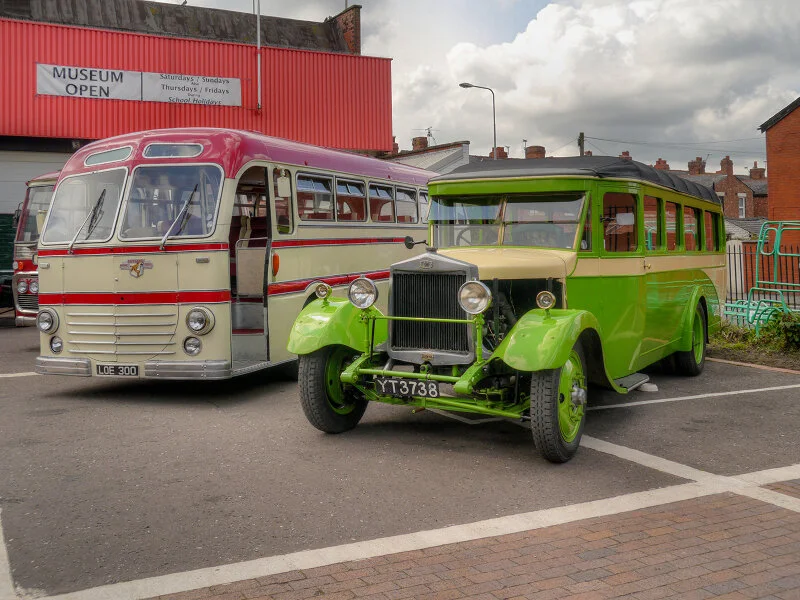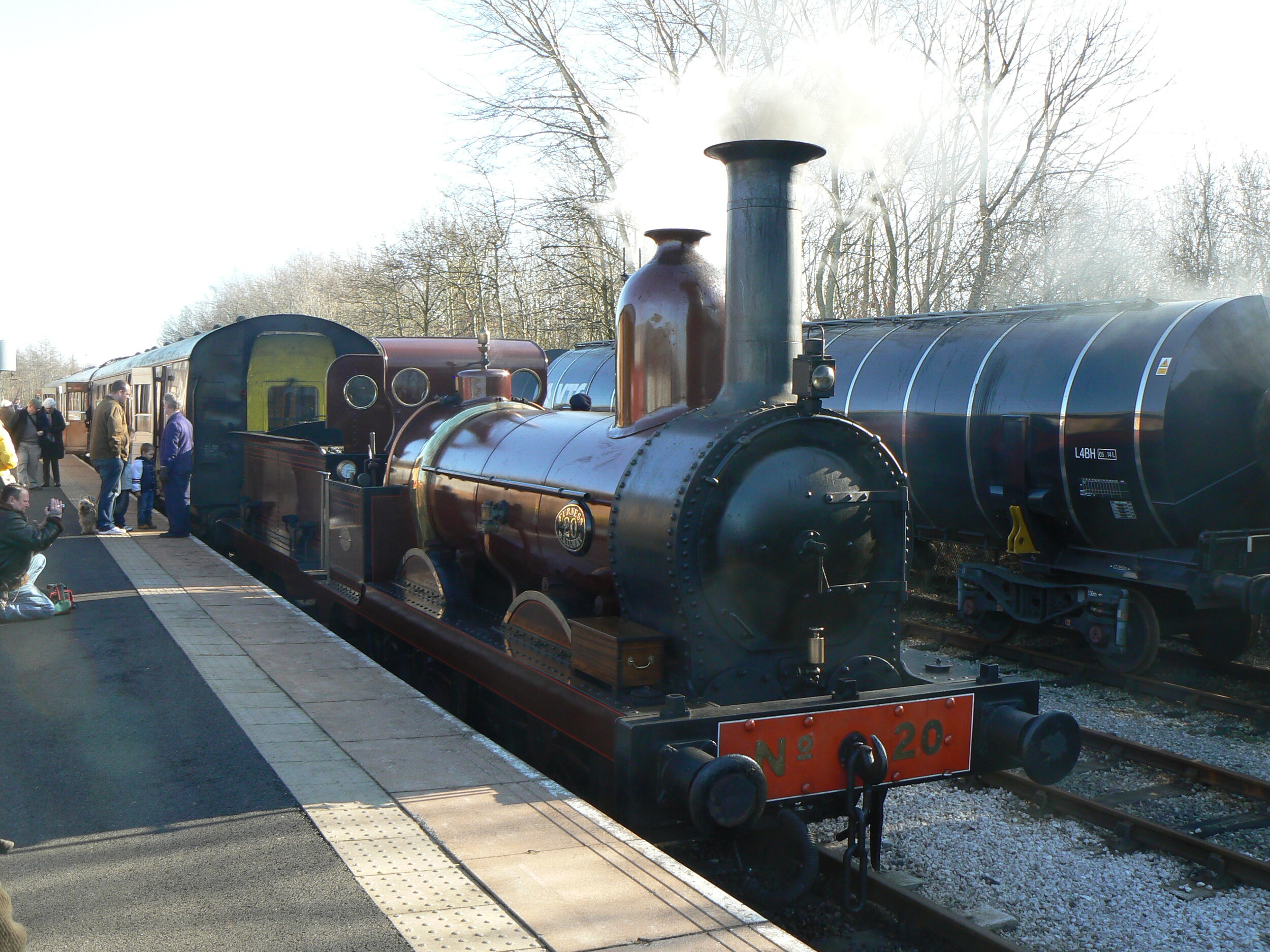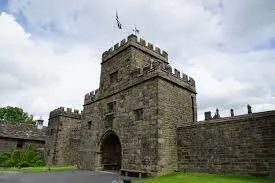
Preston
Deepdale. Home of Preston North End
Commercial Vehicle Museum
Salmesbury Hall
Ribble Steam Railway
Hoghton Tower
Blackpool
CITY
Introduction:
Preston, lying on the River Ribble, in the centre of Lancashire, was granted City Status to celebrate the fiftieth anniversay of Queen Elizabeth II accession to the throne.
Brief History:
Starting as a village called “Priest’s tun” by the 12th century it had become a town. This was due to its location. It sat on a river which could be bridged and sat on the main north/south road which ran through England. By the end of the middle ages Preston was a fairly large town for the period.
Tudor times saw prosperity with linen and wool industries established. The town then became embroiled with disputes between England and Scotland and in 1648 and 1715 the Scots marched on to Preston and each time they were routed.
By Georgian times trade had increased and imports and exports were shared with Europe, the Baltics and even the West Indies. Stagecoaches visited the town and a canal to Lancaster was built. By now the wool trade had changed to cotton which involved 40 cotton mills.
The Industrial Revolution brought leaps in population which was countered by poor sanitation and then a pharmacy and Infirmary came into being. Gradually the usual town amenities were introduced and the docks flourished.
Then in the early 20th century the industrial landscape changed. Cotton collapsed but was replaced by Leyland Motors, electrical goods and engineering, including aircraft construction.
Post World War 2 and decline again, with the rayon factory closing and Leyland had many problems. In 1958, the Preston by-pass was built, which was in reality the first stretch of motorway in the country. Then the two major shopping centres were built, St. Georges and Fishergate, and prosperity slowly returned. In 2002 the city was made a city in celebration of the Queen’s Golden Jubilee. The current population is 134,000.
Things to Do:
Harris Museum:
This important Museum and Art Gallery, located in the city centre, has a good range of exhibitions including Historical artefacts, Archaeology, Costume, Coins, Photography etc. Opened in 1893 this free facility is open until 5pm Monday to Saturday. Located in Market Square, PR1 2PP, there is also a café and shop. Further info can be found at www.harrismuseum.org.uk.
Ribble Steam Railway:
This steam railway museum possesses one of the largest collections of locomotives in the country. Based in the old Preston Docks, on the north bank of the Ribble, visitors can enjoy short train rides, the museum and café. Located on Chain Caul Way, PR2 2PD, you can travel by buses 88C and 75 from Preston station, or even take the short walk from same. If travelling by road, proceed to the city centre and look for Riversway Docklands and then the sign for Steam Railway. For full details regarding opening times etc. check out www.ribblesteam.org.uk.
Samlesbury Hall:
This fabulous black and white medieval house was built in 1325. By being saved from demolition in the 1920’s the history and beauty of the building can be enjoyed by all generations today. You can absorb the antiques, art, heritage, gardens, and then visit the café and restaurant and gift shop. Entrance is free and open from Sunday to Friday. The website www.samlesburyhall.co.uk or by emailing enquiries@samlesburyhall.co.uk will provide all information. Located on Preston New Road, the satnav is PR5 0UP.
Museum of Lancashire: Currently Closed. May open at a later date.
To learn about everything Lancashire this is the museum to visit. Lancashire people, at work, at play, history, at war and law and order etc. can all be found in the exhibitions and displays on show. Located on Stanley Street, PR1 4YP, entrance is free and is open until 5pm from Tuesday to Sunday. Web page is www.lancashire.gov.uk/museumoflancashire.
Hoghton Tower:
Standing on top of the highest point in the area, Hoghton Tower is a fortified manor house. You can visit the state rooms, banqueting hall and minstrel’s gallery together with the dungeons and Tudor Well house. It is reputed to be the third most haunted house in Britain. There is also a permanent doll’s house collection and walks around the walled gardens and ramparts. Due to the nature of the property, opening times are seasonal and vary around other functions. Check out www.hoghtontower.co.uk for opening times and directions.
Lancashire Infantry Museum:
Having taken part in the American War of Independence, Waterloo, Somme, Afghanistan etc. it is taken that the museum is crammed full of treasures. As it is located at a military establishment, Fulwood Barracks, PR2 8AB, it is expected that security is tight. Adult visitors should take some ID with them, such as a driving licence. As well as an interesting tour there is also a shop. For opening times and other important information write to enquiries@lancashireinfantrymuseum.org.uk or visit web site www.lancashireinfantrymuseum.org.uk.
British Commercial Vehicle Museum:
If you love old trucks, vans, buses etc. this museum is a must. It is very hands on plus a cinema to watch archived material, past times are brought to live, fire engines are on the move ringing their bells etc. There is also a café and shop. Located outside the city, in Leyland to the south, opening is seasonal and therefore check out www.commercialvehiclemuseum.co.uk for full details of location and visitors opening times etc.
Blackpool/Southport:
Just west of the city lie Blackpool and Southport seaside resorts. Looking out to the Irish Sea these places make a complete change to inner city attractions. Promenades, piers, fun fairs etc are all to be found. From Preston Bus Station route 61 takes you to Blackpool and route X2 to Southport. Alternatively there is a train connection to Blackpool.
Night Life:
A dozen night clubs and bars can be found in the city centre, mainly in Fishergate/Church Street and roads leading off. A gay venue can also be found in Grimshaw Street.
Having a student population ensures many busy pubs can be found.
For theatre, drama, music, comedy etc. then Preston Guildhall and Charter Theatre is the place to head. Located on Lancaster Road, PR1 1HT, full programme details can be found at www.prestonguildhall.com.
Cinema screens are provided by Odeon in Riversway and by Vue in London Way, Walton-le-Dale.
Eating Out:
Although one of the smaller cities, the variety and quality of food is good. Indian, Soul, American, Italian, British, Chinese can all be found in the city centre restaurants. There are also many pubs, hotels, cafes, takeaways etc. to be found.
Shopping:
Two inner city malls, Fishergate and St. George’s, together with Deepdale, a little further out, should provide a good shopping experience. These malls possess department stores and popular national chains. There are also many independent and boutique shops strung along the main streets.
Accommodation:
International and national hotel chains, together with hostels, pubs and guest houses give a good mix of accommodation in the city.
Transport:
Buses:
A couple of dozen routes serve Preston and its suburbs, with the vast majority using Preston Bus Station. (The bus station is reputed to be the second largest in Europe with 80 bus bays. It has a multi storey car park above and is now Grade 2 listed). Its location is Tithebarn Street, PR1 1DJ. Full info on routes, timetable etc. can be found at www.prestonbus.co.uk. National Express also uses the bus station.
Road:
Preston has good road access. To the east of the city the M6 Glasgow to Midlands runs and this leads on to the M1 to London and the M5 to Bristol, West of England and South Wales.
South of the city the M65 leaves the M6 and serves the towns of Blackburn, Accrington and Burnley. Similarly the M61 leads to Greater Manchester.
East from the city the A59 leads to Harrogate and York and west from the city it leads to Liverpool.
Railway:
The city is an important railway hub, sitting on the main line route from London to Glasgow. In addition the whole of Great Britain can be accessed with easy changes. This means that all the main International Airports can be reached easily. The station is located at the western end of Fishergate. Check out www.nationalrail.co.uk.
Air:
Manchester, Birmingham and London airports can be considered for use for international travel with good train and coach connections.
Taxis:
A dozen taxi firms operate within the city.
CLUB
PRESTON NORTH END
Stadium: Deepdale. Sir Tom Finney Way. Preston. PR1 6RU
Founded: 1878
Joined League: 1888
Chairman: Craig Hemmings
Manager: Ryan Lowe
Current League: Championship
Phone Number: 0844 856 1964
Email: enquiries@pne.com
Fans Forum:- www.pne-online.net
Brief History:
PNE are unique in Football League history in that their glory days were in the first two seasons of the League.
Starting out as a cricket club in 1863 the then club turned to association football in 1878. The club gradually turned professional and in 1888 were founder members of the League together with the other eleven. Amazingly, the team won the League Championship and the FA Cup in the first season of the League. The double at the first attempt. Then, they won the League again in 1889/90. These feats earnt them the nickname of “The Invincibles”.
They have played at Deepdale since the formation of the League and are now the only one of the original twelve to be playing in their original ground.
Then, up to the First World War, the club were relegated twice to Division 2 and bounced back immediately. A similar pattern continued post war with relegation and promotion and then in 1938 they lifted the FA Cup for the second time.
Post World War 2 the star of the team was Tom Finney but he could not help the club to win the League or the FA Cup. In truth by now the Lillywhites could not compete with the big city clubs and a slow decline set in. Inevitably third and fourth tier football beckoned but as football history shows the club did eventually climb back to the second tier (now Championship) and in November 2006 topped the second tier for the first time since 1951. However, they never gained promotion.
In 2008 PNE lost in the playoffs in their aim for Premier League football and they then slid back to League one. They then lost out for promotion in the 2013/2014 season but fortune shone on them when they gained promotion back to the Championship in 2015.
Honours:
League Champions:
1889. 1890.
F A Cup Winners:
1889. 1938.
Match Day:
Tickets:
Away fans should check with their own club about buying tickets.
Tickets can be bought at the ticket office at Deepdale (check web site for opening times) or alternatively by telephoning 0344 856 1966. Tickets can also be purchased on line by visiting www.mypne.com.
Transport:
Bus:
From Preston Bus Station routes 19/19A pass the stadium. If arriving by train take a bus to the Bus Station and change there.
Rail:
As mentioned above trains to and from Preston cover the whole country so are a good means of travel for fans of all clubs. After arriving at the station either take a bus to the stadium, changing at the bus station, or take a taxi.
Car:
Finding the ground by car is simple. From wherever, travel up the M6 (Preston-by-Pass) and leave at the A59 junction and travel west towards the city centre. You will come across a roundabout which turns right onto the A5085, Blackpool Road. Take this road until you reach Lowthorpe Road on your left. The club have two car parks at the ground and the club should be contacted regarding availability. On match days there is also parking at nearby Moor Park School, with a fee of £5.
Air:
Manchester is the viable airport for travelling to Preston. See above.
Taxi:
You can pick up a cab throughout the city to get you to Deepdale.
Stadium:
Deepdale is the only stadium Preston North End have played in at home. The current design and layout was commenced in 1995. The West Stand made way for the new Tom Finney Stand which also houses restaurants and the press. Then came the Bill Shankly Kop which housed the National Football Museum. Following came the Alan Kelly Town End which replaced the Town End terrace. Finally, the old Pavilion terrace was demolished and replaced with the Invincibles Pavilion which contains executive boxes and a restaurant.
Outside of the Tom Finney Stand is a statue of the great player.
The National Football Museum was housed at Deepdale between 2001 and 2010, when it relocated to Manchester
The ground record crowd is 42,684 v Arsenal in 1938 and the current capacity is 23,404.
Away fans are seated in the Bill Shankly Kop which is steep and gives good views of the action. The fare on sale is excellent, with a local delicacy the “Butter Pie” being an original offering. There are a few nearby watering holes which generally, but not always, welcome visiting fans.
There are stadium tours available and also a club shop. Contact the club website for information.






